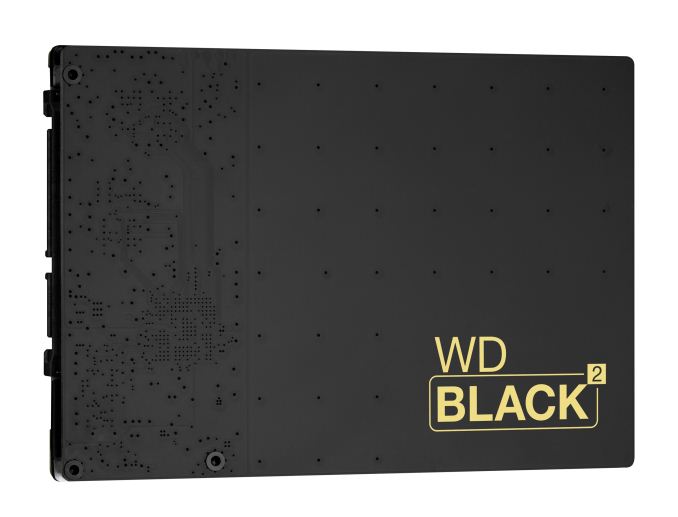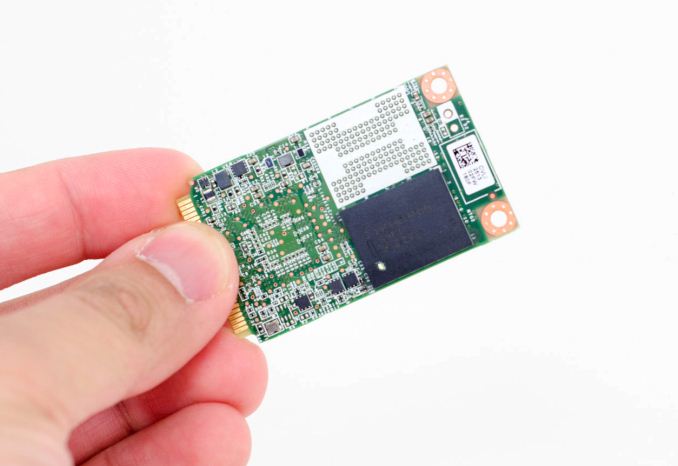The WD Black2 Review: World's First 2.5" Dual-Drive
by Kristian Vättö on January 30, 2014 7:00 AM EST
If you had asked me a few years ago, I would've said that hybrid drives will be the next big thing in the storage industry. Seagate's Momentus XT got my hopes up that there is manufacturer interest in the concept of hybrid drives and I was expecting the Momentus XT to be just the beginning with more announcements following shortly after. A hybrid drive made so much sense -- it combined the performance of an SSD with the capacity of a hard drive in an affordable and easy to use package.
Seagate's Momentus XT showed that even 4GB/8GB of NAND can make a tremendous impact on the user experience, although it couldn't compete with a standalone SSD. The reason for that was the very limited amount of NAND since the speed of an SSD relies on parallelism: a single NAND die isn't fast (though for random IO even it's still far better than a hard drive), but when you combine a dozen or more dies and read/write to them simultaneously, the performance adds up. I knew the Momentus XT was a first generation product and I accepted its limitations, but I truly expected that there would be a high-end drive with enough NAND to substitute for an SSD.
It turns out I was wrong... dead wrong. Sure Seagate doubled the NAND capacity to 8GB in the second generation Momentus XT, but other than that the hybrid drive market was pretty much non-existent. Western Digital showed their hybrid drives over a year ago but limited them to OEMs due to a unique connector. To be honest, I've not seen WD's hybrid drives used in any systems, so I'm guessing OEMs weren't the biggest fans of the connector either.
As the hard drive companies weren't able to come up with decent hybrid offerings, the PC OEMs had to look elsewhere. Intel's Ultrabook concept was a big push for SSDs because Intel required at least 20GB of flash storage or the OEM wouldn't be able to use Intel's Ultrabook branding. Of course Intel had no weapons to stop OEMs from making ultraportables without flash but given the millions Intel has spent on Ultrabook marketing, it was worthwhile for OEM's to follow Intel's guidelines. Since the PC market kind of pushed itself into a corner with the price war, it wasn't possible for PC OEMs to do what Apple did and go SSD only due to prices, but on the other hand Ultrabooks had no space for two 2.5" drives. The solution? mSATA.
mSATA is barely the size of a credit card
Unlike hard drives, SSDs didn't have to be 2.5", it was simply a matter of compatibility with existing systems. What mSATA did was allow PC OEMs to build hybrid storage systems while keeping the Ultrabook spec and form factor. In my opinion this was a huge yet missed opportunity for hard drive OEMs. All they would have needed to do was build a hybrid drive with at least 20GB of NAND in order to meet the Ultrabook spec. I bet many PC OEMs would have chosen an all-in-one hybrid drive instead of two separate drives because managing a single supplier is easier and assuming sufficient volume the pricing should have been competitive as well.
When SSDs first appeared in the consumer space, the hard drive companies didn't feel threatened. The pricing was absurd (the first generation 80GB Intel X-25M cost $595) and performance wasn't much better than what hard drives offered. Back then SSDs were only interesting to some enthusiasts and enterprises, although many were unconvinced about the long-term benefits since the technology was very new. The hard drive companies had no reason to even think about hybrid drives as traditional hard drives were selling like hot cakes.
Today the situation is very different. Let's take the 80GB Intel X-25M G1 and 240GB Intel SSD 530 as examples: the price per gigabyte has dropped from around $7.50 to $0.83. In percentage points, that's a massive 89% decrease. Drops this big are impossible to predict as they usually aren't intentional and neither was this one. The reason why NAND prices dropped so rapidly was the oversupply caused by large investments made around 2010. The sudden increase in NAND demand due to the popularity of smartphones and tablets made the NAND business look like a good investment, which is why many companies invested heavily on it. While smartphone and tablet shipments continued to increase, the thing NAND fabricators didn't take into account was that their capacities didn't (at least not very quickly). In other words, the NAND fabricators expected that the demand for NAND would continue to grow rapidly and increased their production capacities based on that but in reality the demand growth was much smaller, which lead to oversupply. Just like other goods, NAND prices are controlled by demand and supply: when there's more supply than demand, the prices have to come down for supply and demand to meet.
SSDs are no longer luxury items. Plenty of systems are already shipping with some sort of SSD storage and the number will continue to grow. The hard drive companies can no longer neglect SSDs and in fact WD, Seagate, and Toshiba have all made substantial investments regarding SSDs. Last year WD acquired STEC, Virident, and Velobit; Seagate introduced their first consumer SSD lineup, and Toshiba has been in the SSD game for years. However, there still hasn't been a product that would combine an SSD and hard drive into one compact package. The WD Black2, the world's first SSD+HD dual-drive, changes that.











100 Comments
View All Comments
nitram_tpr - Thursday, January 30, 2014 - link
Ouch, that is one expensive drive. As you say, it appears to be the ideal solution for a laptop with only a single drive bay. I think there is another option - change the HDD for an SSD and put the HDD into the optical drive bay with an adapter.ddriver - Thursday, January 30, 2014 - link
It is kind of expensive and kind a slow and power hungry for an SSD, but still it is essentially 2 hard drives in one. I would actually get this if the SSD part was a tiny bit better. I don't think the presence of mechanical drive in the case mandates the SSD performance be any lower. I think I will just install an extra drive in the optical drive bay, seriously DELL what were you thinking who uses optical storage in 2012?lmcd - Thursday, January 30, 2014 - link
Me.Thanks Dell for considering :-)
ddriver - Thursday, January 30, 2014 - link
Poor you :) I maintain about 20 TB of data, in the past the database was much smaller so I used to back it up on CDs, then DVDs, but the damn things are just too slow, unreliable, small and the cost of storage was very high. It was this moment I began hating optical storage with passion, my life got marginally better when I destroyed all optical disks and moved everything to hard drives - faster, cheaper, more compact and reliable.I know manufacturers provide installation disks which some people end up using for years, failing to realize the software on that disk is usually out of data before they even made the purchase.
And for all scenarios a hard drive is overkill there is the USB flash drive.
I guess optical storage makes some sense on consoles and/or media center PCs, if you watch many bluray or dvd movies, but for everything else... meh... and on that dell laptop it is just dead weight and battery drain.
Morawka - Thursday, January 30, 2014 - link
Try blu ray man, blu ray's will match HDD's capacity in the near future. At present, it can already match SSD's capacity of 128GB.The blu ray tech is good up to 25 layers @ 32 GB per layer = 800 GB
Optical is far from dead when America has some of the worst bandwidth in the world.
Gigaplex - Thursday, January 30, 2014 - link
So I'd need 5 Blu-ray discs per hard drive, which would take 15 hours to write at 16x speed.JHBoricua - Thursday, January 30, 2014 - link
But what happens when one of those 4TB drives fails? Assuming you have them in a RAID array, it will probably take as long or longer for the array to rebuild, not to mention that at those capacities, the risk of another drive failing during the rebuild are simply too great if you care about your data.ddriver - Friday, January 31, 2014 - link
I don't raid, I just backup. This is IMO better. I could raid something for performance but never for safety.name99 - Friday, January 31, 2014 - link
Jesus, You sound like iOmega with the endless succession of ZIP and JAZ drives, or Cringely talking up his aluminum foil based drive (which still has not seen the light of day).So the best Blu-Ray could do (in drives that don't exist, using disks that don't exist) is a very slow version of a drive that I can buy for around $50?
Good luck getting rich with that particular technology.
Optical is dead dead dead. And quit whining about "worst bandwidth in the world" you drama queen. Go to a real third world country and see what really bad connectivity looks like. The only problem most Americans have is that they will have to wait five minutes for their drivers to download rather than 20 seconds. That's just not enough pain to keep optical relevant.
TheinsanegamerN - Saturday, February 1, 2014 - link
you forget the very restrictive bandwidth caps, the terrible customer service, the awful reliability, the throttling of data, the list goes on.